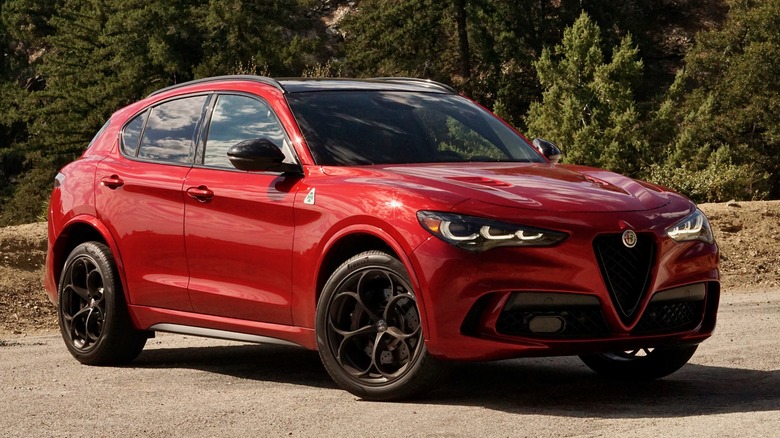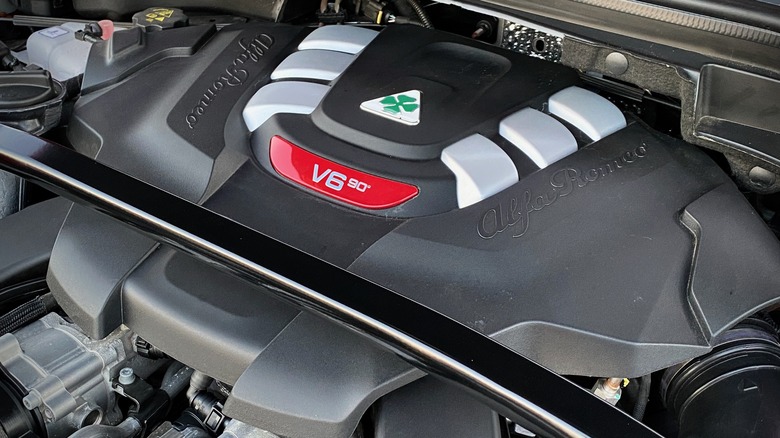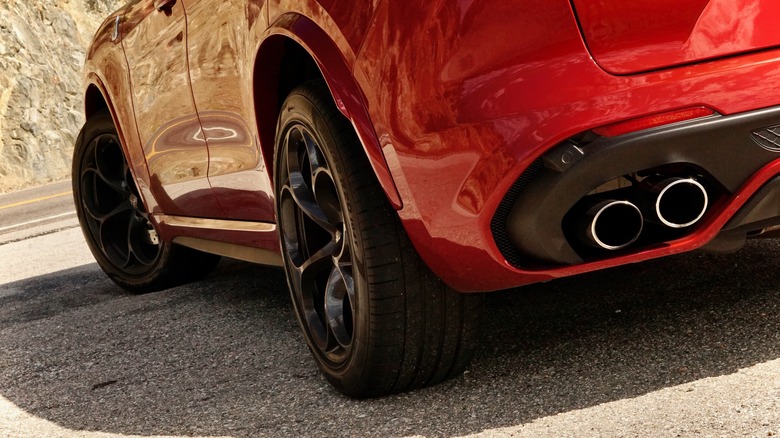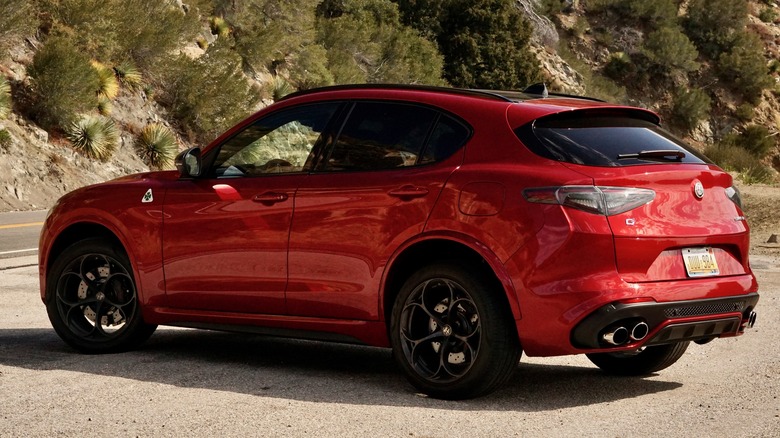The Alfa Romeo Quadrifoglio Engine Is Being Discontinued: What Should Replace It?
The Giulia and the Stelvio make up two thirds of Alfa Romeo's lineup in the United States these days — with the only other new Alfa you can purchase being the Tonale. The Giulia and Stelvio, a sedan and an SUV, are both attractive, upscale vehicles with a number of different trim levels to choose from. The Giulia and Stelvio are both offered with a Quadrifoglio trim level, a name with its roots going all the way back to the race-winning Alfas of the 1920s. The Stelvio and Giulia Quadrifoglio are powered by a Ferrari-sourced twin-turbocharged 2.9-liter V6 – a high-horsepower engine that gives them a unique character in their respective classes.
The V6 produces 505 horsepower and 443 lb-ft of torque and makes for competitive acceleration times amongst high-performance rivals. Unfortunately, the 2.9-liter V6 has seen its last days. The final edition versions of the Stelvio and Giulia were announced earlier this year and their arrival signified the end of production for the Quadrifoglio engine. The Quadrifoglio Super Sport is a limited-edition version of both the sedan and the SUV, with numbers limited to 72 Giulias and 52 Stelvios in the United States, powered by the 2.9-liter V6 and it is the swan song for the Quadrifoglio as we know it. But Alfa hasn't announced what will take its place. Instead, they've alluded to an electrified future, opening up all sorts of possibilities for the Quadrifoglio. Meanwhile, we're left to wonder what exactly that means.
What's the Ferrari-sourced V6 like?
Before we wave goodbye to the twin-turbocharged 2.9-liter V6, let's wax nostalgic for a minute. It revs ultra-fast, makes all sorts of lovely noises, and it will certainly be missed. The V6 gets most of its architecture from Ferrari's F154 3.9-liter twin-turbo V8 with both all-aluminum engines using a 90-degree V layout. The Alfa Romeo engine also uses single-scroll turbos instead of twin-scroll turbos (what the Ferrari engine uses) which means that a lot of power is made at the top of the rev range. Burying your foot in the throttle and ringing the engine out all the way to redline is a joyous experience – just make sure you've got enough road ahead of you.
In Car and Driver testing, the Giulia Quadrifoglio went from zero to 60 mph in just 3.6 seconds, blasting through the quarter-mile marker in 11.9 seconds at 121 mph. Give the Giulia just over 20 seconds and it will be doing 150 mph. The Giulia, however, is rear-wheel drive only – limiting it's off-the-line acceleration. The Stelvio, using the same power and all-wheel drive, is even faster. In Car and Driver testing, the Stelvio Quadrifoglio went from zero to 60 mph in an astonishingly-fast 3.3 seconds, hitting the quarter mile 11.8 seconds at 116 mph. Reaching 150 mph takes 23.9 seconds for the Stelvio, slightly slower than the Giulia, but still a level of acceleration that will easily challenge most sports cars on the road today.
What will power future Quadrifoglio models?
So, the V6 is fast and furious, but what will take its place? It seems likely that it would be a hybrid or a fully-electric powertrain. That may infuriate some Alfa enthusiasts, but it seems inevitable that the future of performance vehicles is at least partially powered by electricity. Larry Dominique, Senior Vice President and Head of Alfa Romeo North America, said that the future of Alfa is electrified. He called the twin-turbo V6 "a fitting final chapter to the combustion engine Quadrifoglio in the US" but before you fret too much about the word "electrified" can mean both hybrid or all-electric when it comes to a vehicle's powertrain. An ultra-fast EV or a high-performance hybrid, offering extra battery power to an already-potent powertrain, could both be fitting choices.
Stellantis, who owns Alfa Romeo, owns a lot of other automotive brands too – both in the United States and around the world. In America, Stellantis brands like Jeep and Dodge could lend a few hybrid powertrains to the Alfas (the plug-in hybrid Wrangler 4xe and Ramcharger come to mind), but they really aren't spicy enough to power a Quadrifoglio. Whatever powers the newest Quadrifoglio, it needs to be inspiring. The Quadrifoglio must be the fast, engaging model in the lineup, focusing on driving dynamics rather than peak efficiency – even if it does have a bit of added electricity. For that, it's worth taking a look at some of the engines outside of Alfa Romeo that future Quads could have access to – specifically in Europe.
Speculating about the future powertrain
Ferrari is no longer part of the Stellantis empire, so it's not likely that a Ferrari powertrain will find its way into the new Quad models. Of course, that's where the facts end and the fun speculation begins. Here, we can guess (and hope a bit) about what could make its way into the Quadrifoglio's engine bay. Maserati is another Stellantis-owned brand and the powertrain from the Grecale would be an excellent choice for Alfa Quadrifoglio models. According to Maserati, the Grecale's 48-volt mild hybrid system works in tandem with a four-cylinder engine to maintain a thrilling performance — sounds like a perfect recipe for the Alfa too.
The ultra-exclusive Alfa Romeo 33 Stradale is another potential (albeit less likely) choice for an engine donation. It uses a twin-turbocharged 3.0-liter V6 that makes over 600 horsepower that would be right at home under the hood of a Quad. Pair it with one of Stellantis' 21-kW eDCT systems and you've got a more-powerful, electrified version of the Stradale with stratospheric horsepower. But the Stradale is also available as an even-more-potent EV with over 750 horsepower – certainly enough to make any Giulia or Stelvio Quadrifoglio models feel seriously peppy. Personally, I believe the Grecale's powertrain is more likely, but if we're dreaming, why not dream big?



